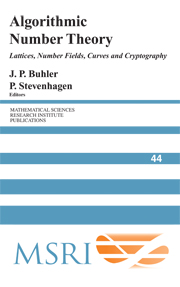Book contents
- Frontmatter
- Contents
- Preface
- Solving the Pell equation
- Basic algorithms in number theory
- Smooth numbers and the quadratic sieve
- The number field sieve
- Four primality testing algorithms
- Lattices
- Elliptic curves
- The arithmetic of number rings
- Smooth numbers: computational number theory and beyond
- Fast multiplication and its applications
- Elementary thoughts on discrete logarithms
- The impact of the number field sieve on the discrete logarithm problem in finite fields
- Reducing lattice bases to find small-height values of univariate polynomials
- Computing Arakelov class groups
- Computational class field theory
- Protecting communications against forgery
- Algorithmic theory of zeta functions over finite fields
- Counting points onvarieties over finite fields of small characteristic
- Congruent number problems and their variants
- An introduction to computing modular forms using modular symbols
An introduction to computing modular forms using modular symbols
Published online by Cambridge University Press: 30 May 2025
- Frontmatter
- Contents
- Preface
- Solving the Pell equation
- Basic algorithms in number theory
- Smooth numbers and the quadratic sieve
- The number field sieve
- Four primality testing algorithms
- Lattices
- Elliptic curves
- The arithmetic of number rings
- Smooth numbers: computational number theory and beyond
- Fast multiplication and its applications
- Elementary thoughts on discrete logarithms
- The impact of the number field sieve on the discrete logarithm problem in finite fields
- Reducing lattice bases to find small-height values of univariate polynomials
- Computing Arakelov class groups
- Computational class field theory
- Protecting communications against forgery
- Algorithmic theory of zeta functions over finite fields
- Counting points onvarieties over finite fields of small characteristic
- Congruent number problems and their variants
- An introduction to computing modular forms using modular symbols
Summary
We explain how weight-two modular forms on 0.N/ are related to modular symbols, and how to use this to explicitly compute spaces of modular forms.
The definition of the spaces of modular forms as functions on the upper half plane satisfying a certain equation is very abstract. The definition of the Hecke operators even more so. Nevertheless, one wishes to carry out explicit investigations involving these objects.
We are fortunate that we now have methods available that allow us to transform the vector space of cusp forms of given weight and level into a concrete object, which can be explicitly computed. We have the work of Atkin–Lehner, Birch, Swinnerton-Dyer, Manin, Mazur, Merel, and many others to thank for this (see, e.g., [Birch and Kuyk 1975; Cremona 1997; Mazur 1973; Merel 1994]). For example, we can use the Eichler–Selberg trace formula, as extended in [Hijikata 1974], to compute characteristic polynomials of Hecke operators. Then the method described in [Wada 1971] gives a basis for certain spaces of modular forms. Alternatively, we can compute ⊝-series using Brandt matrices and quaternion algebras as in [Kohel 2001; Pizer 1980], or we can use a closely related geometric method that involves the module of enhanced supersingular elliptic curves [Mestre 1986]. Another related method of Birch [1991] is very fast, but gives only a piece of the full space of modular forms. The power of the modular symbols approach was demonstrated by Cremona in his book [1997], where he systematically computes a large table of invariants of all elliptic curves of conductor up to 1000 (his online tables [Cremona undated] go well beyond 100,000).
Information
- Type
- Chapter
- Information
- Algorithmic Number TheoryLattices, Number Fields, Curves and Cryptography, pp. 641 - 652Publisher: Cambridge University PressPrint publication year: 2008
